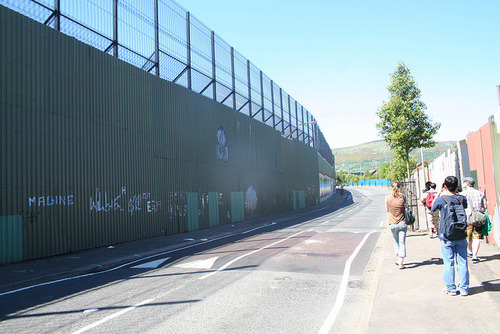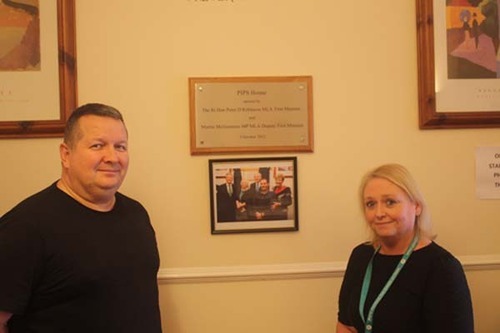 A peace wall at Cupar Way in West Belfast, separating the Catholic Falls Road from the Protestant Shankill Road.
A peace wall at Cupar Way in West Belfast, separating the Catholic Falls Road from the Protestant Shankill Road.
Belfast's Lesser Known Violence
By Michael Lee-Murphy
By Michael Lee-Murphy

A peace wall at Cupar Way in West Belfast, separating the Catholic Falls Road from the Protestant Shankill Road. (Robin Kirk/Duke Human Rights Center)
As decades of the Rosary dragged by, the slack of years ago hauled up
Bead by bead, and with them, all the haberdashery of loss.”- Ciaran Carson, Belfast poet, from “Snow”
This summer, like many summers before it, has been a violent one in Belfast. The summer parading season has seen a number of protests, counter-protests, and the kind of street fighting Belfast has become known for over the years. Belfast is once again in the international news headlines,15 years after the Good Friday Agreement was supposed to have brought an end to the 30-plus years of ethnic conflict between Irish-Republican Catholic communities, British-loyalist Protestant communities, the British Army, and various paramilitaries. Richard Haas, president of the American Council of Foreign Relations, has been dispatched to the city for the next few months to chair talks addressing “sensitive issues and disputes, including parades and protests; flags, symbols, and emblems; and related matters stemming from the past in order to make the peace more resilient going forward.”
There is another kind of violence on the rise here. If it is addressed in Haas’ all-party talks, it will be as a footnote to questions of ‘flags, symbols, and emblems.’
Over the past several years, suicide rates have skyrocketed, and Belfast has developed an extensive suicide prevention and bereavement counseling infrastructure relative to its population of 280,000. North, South, West, and East, every quadrant of Belfast has at least one office offering suicide prevention counseling services, and in some areas there are multiple. According to a councillor at one such office in north Belfast, the workload has gone up 180% in recent years.
Belfast is a divided city in almost all facets of life. Neighborhoods, newspapers, soccer teams, and sometimes sports themselves are divided between the two communities. The growing crisis of suicide unites the two. In North and West Belfast, where Catholic and Protestant communities exist in close proximity, suicide rates are more than double the United Kingdom average.
The raw numbers are striking. Between 1999 to 2012 – the years since the Good Friday Agreement brought Sinn Fein, the largest Catholic-Republican party, into government with the Democratic Unionist Party, the largest Protestant party – over 3,100 people took their own lives, more than had done so in the previous 22 years. Of those 3,100 suicides, more than half took place after 2007. For comparison, roughly 3,500 people died during the 30 years of the Troubles.
For Jo Murphy [no relation], the director of Lighthouse, one of the oldest suicide prevention centers in the city, the numbers are not what we should focus on. “People get caught up in the statistics,” she told me, “and that can do great damage in our communities.” For Murphy, each suicide is an “individual story, and in some ways different than any other death.” The two thoughts that immediately arise after a suicide, said Murphy, are “Why?” and “If only…”
********
The answer to the first question is, as everything is here, tied up in notions of the past. People between the ages of 15 and 24, and adult males between the ages of 45 and 55 are the hardest-hit groups, according to Martina McIlkenny and Joe Morgan, directors at PIPS, a suicide prevention program in North Belfast. For both age groups, ‘the Troubles’ are still very real. Young people in working-class areas are often stopped and searched by police, as well as recruited by MI5 – the British domestic spying agency – to become informants in their own communities, according to McIlkenny. For the older age group, men between 45 and 55, many are former paramilitary members, or ‘combatants’ as people here refer to them. McIlkenny explained that for many of these men, there are no real support structures, and PTSD is common.
During the Troubles, when people performed ‘operations’ – violent acts – they did so out of a sense of duty, whether for the anti-imperialist notions of a united Ireland, or an allegiance to a sense of Britishness and the Queen. “They can’t go into the hospital and say ‘excuse me, I killed someone,’” McIlkenny told me as we sat in a counselling room at PIPS.

Joe Morgan (left) and Martina McIlkenny, directors at PIPS (Photo by Michael Lee-Murphy)
Perhaps reflecting the scope of the problem, the PIPS building is quite a large establishment. There is an entire floor of counseling rooms, furnished with comfortable couches. The rooms are candlelit. It is a world apart from the other type of dimly lit room that, according to Mcilkenny and Morgan, is the preferred method of group support here: the neighborhood bars and pubs that serve to numb memories of war.
Mike Tomlinson, a professor of Social Policy at Queen’s University Belfast, put it in more academic terms in a 2012 paper on suicide in Northern Ireland. “The transition to peace means that externalized aggression is no longer socially approved. It becomes internalized instead,” he wrote.
According to Morgan, the next group that will be hardest hit by suicides are middle-aged women. The literature on suicide in post-conflict zones can predict the trajectory of those groups of people who most commonly take their own lives – from the children of combatants, to the combatants themselves, and then to the women who have been providing support for years without any real support structure for themselves.
“We’re still picking the pieces up from the war that’s supposed to be over, but in reality is still going on,” Morgan told me.
Part of the challenge for places like PIPS and Lighthouse is to get people through the door in the first place. A lack of support services in traditional medical establishments, the prevalence of drink, and a cultural stigma around suicide itself all conspire to keep people from seeking support in Belfast. Connecting to the young is especially hard, says Morgan who has turned to social media to help bring young people through the doors of PIPS. Morgan is a year into the job coordinating events and fundraising at PIPS.
Indeed, PIPS’ Facebook page has over 6,000 likes. (Here is another clue to the scale of the problem: Look up the Facebook page for an equivalent organization in your local city. It almost surely has less recognition.)
********
Last month, as Belfast saw some of the worst rioting in years in its downtown core, the East Belfast Community Development Agency delivered 20,000 suicide prevention pamphlets across the strongly Protestant working class east of the city. Unsurprisingly, suicide hits those from working-class areas the hardest.
The Northern Ireland Multiple Deprivation Measure measures a person’s social deprivation based on “income, employment, health, education, proximity to services, living environment and crime and disorder.” According to a recent tally, suicides over the last ten years in Northern Ireland are weighted at the poorer end of this spectrum.
“I do think it is a scourge of working-class society,” Máirtín Ó Muilleoir told me. Ó Muilleoir is Belfast’s current Lord Mayor, and also told me about the sadness he felt following the suicide of a well-known West Belfast priest, Matt Wallace. Known locally as “the people’s priest,” Wallace was a “champion of the working class,” Ó Muilleoir said. His death came as a shock for the communities he served, and illustrates the extent of the problem here.
********
Belfast’s dead poets can still describe this place like they’re reading the newspapers from the grave. Writing about his hometown in his 1934 poem “Valediction,” Louis MacNeice wrote that Belfast is “built on reclaimed mud […] country of callous lava cooled to stone.” In the same poem, MacNeice also wrote that in Ireland “history never dies, […] arson and murder are legacies.”
Indeed, there are a few elements of the callous lava that still bubble beneath the cooled stone of the North, 15 years into what they call the peace process. Belfast is still the type of place where kids, most of whom are far too young to remember the bad years of the Troubles, feel enough anger and alienation to throw stones and Molotov cocktails at the police – or whoever – over things like the taking down of the British flag from Belfast city hall (angering Protestants) or the annual marching of Protestant fraternal organizations through Catholic neighborhoods (angering Catholics).
The past – and the pain of the past – still resonates here, like a sound. Many are still tuned to the same frequency, and the pain of the past becomes the pain of the present.
September 10th is World Suicide Prevention Day. After a cross-community service prayer service, PIPS will host a ceremony at the Waterworks park in North Belfast. Anyone who has lost a loved one to suicide can send a water lantern out into the park’s pond.
You can follow Mike on Twitter @mickleemurph
Michael Lee-Murphy
Reporter. A furious return to basics. Right hands as referees.
Catch up with me @Mickleemurph.

